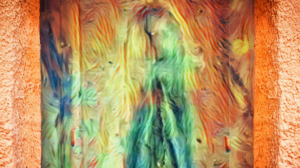
Maria first saw her on a blessed Tuesday. She was walking home from work as usual, bent and tired. She climbed up the steep, cobbled hill to her apartment, painfully clasping two bags of groceries in her arthritic hands. She was thinking about dinner. She planned on scrambling a few eggs and frying a tortilla, nothing fancy, she was too tired. Besides, she lived alone now, and there was no joy in cooking for one. Her sainted Horacio had gone to meet Christ 10 years before, and her son and daughter had gone to the States. They seemed even farther away than Horacio. He, at least visited her in dreams, always looking just as he had before he died. He’d ask about her arthritis, say she looked well and bless her. Her children however, never visited and rarely called. They’d send her pictures on Christmas and Cinco de Mayo. As if they’d forgotten that Cinco de Mayo was a gringo holiday. The real day of independence was Grito de Dolores on September 16, but they never sent her anything in September. Nor did they seem to remember their saint’s days, or Virgin of Guadalupe day, on December 12. In the photos they beamed out at Maria, like wealthy strangers who had forgotten God.
Maria sighed and glanced up at her apartment. There, delicately outlined in smudgy green/grey lines in the cracked plaster surface, was the Virgin of Guadalupe—saintly and serene, as unmistakable as a sunrise, as inevitable as bad fortune.
Maria dropped to her knees right there in the street, not even conscious of her bags of groceries, one of which contained eggs. The eggs shattered. It would have been a miracle if they hadn’t and one miracle a day is more than enough.
Thick, viscous fluid oozed around Maria’s knees, but she didn’t even notice. Her veined brown hands folded together in supplication. Her lips muttered thanks and prayers. Her heart sang. An hour passed without her realizing.
She was startled from her trance by a rude noise behind her. It was the boys on the corner, whistling at guera tourists. She sighed; they were not bad boys, they just lacked proper supervision and a visible future. Creakily she rose to her feet, bending to gather her broken groceries. Her joints ached, but her heart was too filled with love for the Virgin to care.
She hardly slept that night. She was ashamed to admit the doubt in her heart, but she was consumed by the uncontrollable fear that the Virgin would be gone in the morning. The next day, on her way to scrub the bathrooms at the hospital, she hesitated before looking up at the wall.
Crossing herself, she cautiously raised her eyes. There, clearly revealed in the golden light of morning the Virgin shone. True, her features were indistinct, but the shape of her robe, halo, and hands was unmistakable.
Maria was shamed and unworthy. She had doubted, but the Virgin had forgiven her. All day long as Maria cleaned, scoured and polished floors, faucets and fixtures, she was filled with exaltation, unaware of the arthritis that curled her fingers and bent her back. At six o’clock, she returned home. Normally she ignored the chollos, passing with eyes downcast. But today she walked toward them, head up, back almost erect.
“Look,” she said, pointing. “Behold, the Virgin.”
They looked. They saw. They believed. There on the dirty street, littered with cigarette butts and broken dreams, they knelt. They crossed themselves. It was a miracle.
Word spread, people began leaving flowers and lit candles at the feet of the Virgin.
Returning home from work on Thursday Maria saw her landlord, Señor Gonzalez. She crossed herself and tried to banish the unchristian thoughts knocking against the door of her mind. Señor Gonzalez stood, scowling as always, up at the Virgin.
Maria inclined her head in a slight bow. “Señor,” she said, “a miracle has graced your building; truly you must be exalted.”
“What are you babbling about, Maria?” he said.
“The Virgin, the Virgin of Guadalupe, she appeared two days ago.” Maria gazed upward.
Gonzalez gazed upward. He choked. “The Virgin? Is that what all this garbage is about?” He kicked over the remains of burnt candles and the wilted flowers, drooping in empty jam jars and littering the street with petals.
“It’s water damage, Maria. If I don’t fix it the whole building could fall down, not that I get enough rent to make repairs worthwhile. I’ll have Roberto and Mario plaster and paint next Monday. We might have to talk about a slight raise in rent to cover the costs.”
“Oh, but Señor, you can’t!” Maria cried. “It is a miracle, a manifestation of the Virgin. Even the street boys have been touched.”
“Well then, let them clean up this mess,” he said, giving the blossoms another boot. “That’s all I need, first water damage and then my building becomes a chollo sanctuary.”
Maria wept and prayed. In a week or three—Roberto and Mario were not noted for punctuality—they would destroy the Virgin. It was a sacrilege. But miracles are not called miracles for nothing.
The very next day, the Virgin’s smudgy green/grey silhouette turned golden, yellow rays, like fingers of God, radiated from her halo. Then, over the course of the next two weeks, day by day her colors grew and intensified. Her cloak darkened to a rich forest green; her dress reddened. Her halo stretched across the building’s exterior, highlighting the cracked plaster with beams of gold.
Every day and late into the night, the people of the pueblo gathered around the dusty feet of the Virgin, watching her grow. Children ate their vegetables. The chollos helped old women carry their groceries. Even the dogs stopped barking. Cats still howled in the night, but felines have always been a faithless species.
By the time Señor Gonzales returned three weeks later with Mario and Roberto in tow, the Virgin was huge, covering almost the entire building. If you squinted and closed one eye, you could even trace the faint outline of a beatific smile. Señor Gonzales was breathless. This was not unusual because he was a tad stout and the hill was steep, but even he could not deny the vision. He fell to his knees and prayed. So did Mario and Roberto. They prayed that they would still get paid, and miracles of miracles they did.
A week later the Virgin began to weep, tears coursed down her cheeks like blood. As if in sympathy, Maria’s eyes watered. Even the chollos, who had surround the bottom of the Virgin’s robes with poles cemented into old coffee tins and girdled them with blinking bulbs of green, red, and white, wept. In fact, the whole town began to weep, even though the Virgin had purged them of sorrow.
Cracks appeared in Maria’s hands and feet. They opened and bled. Stigmata, an undeniable sign of heavenly favor. Her vision grew misty. Through clouded eyes, the Virgin’s face looked softer and more sympathetic. Tiny Jesús, who was only a year old, began to bleed too. His parents assumed it was baby stigmata, because blood poured not from palms or feet but from his nose.
Maria prayed silently. She wanted to sing exaltation to the heavens, but her throat was too sore. In fact, everyone’s throat was sore, despite their blessing, the town grew quieter than it had ever been. Lassitude covered the pueblo like smoke from burning, mass incense.
Husbands stopped beating their wives. Even the cats and roosters fell silent. In the schoolyard, the children were as quiet as old men. Señor Gonzales’s appetite for worldly things vanished. He stopped eating and grew as gaunt and skeletal as the Christ.
The pueblo rested, as heavy with peace as though they had marched up the hill to the crucifixion, carrying a lead cross.
Father Barros said the exhaustion must be caused by unacknowledged evil, the wheezing of their lungs the product of unvoiced blasphemies. God was making secret depravities manifest. The Virgin had come and they were being judged. He commanded that the confessional booth remain open 24-7. It overflowed with tearful congregants. Their heads ached with unremembered sins.
As the Virgin flourished, extending her golden rays over nearby buildings, the only sounds in the pueblo were the rasping of breath and the clicking of rosaries. But despite the blessing it was difficult to pray. No one, not even Father Barros could remember the holy rites. Even the rosary became a string of words too long to recall.
The Virgin spread. Beginning in each village as a tiny grey/green impressionist sketch, dashed off by the hand of God. It was indistinct as a blur in the retina, or the mind. But soon the Virgin ripened, golden rays reached up and down the coast, metamorphosing into frescos of glorious sunset color.
It was two years later that a select team of mycologists reached the quiet town.
“Be sure that your masks are secure,” said Dr. Maria Guadalupe Guerra, tightening the clear plastic respirator encircling her face. It was attached to a portable oxygen tank, no bigger than a carry-on. Behind her she dragged an enormous fogger.
“We believe this may have been the first town to have been hit,” she said.
“So this is where it all began,” Dr. Mario Jesús Santiago said. He would have whistled, but the mask and tube restricted him.
“Yes,” she nodded slightly. “This where it started. Now it’s so huge, it’s almost impossible to eradicate, but eradicate it we must, or it will kill the entire country.”
“I still don’t understand it,” said Dr. Santiago, fidgeting with the settings on his fogger. “This must have started as a small contagion, a few gray/green spores, visible to the naked eye that could easily have been destroyed. The residents would have had to have seen it.”
“How could this have happened? How could a mold, so simple to extinguish in its early stages, been allowed to spread unchecked? It would have taken months to have developed this range of colors, let alone spread along the entire coast?”
“It’s just one of those things we’ll never know,” sighed Dr. Guerra, as she crossed herself.
Watch the story read live here, on our YouTube channel, by Yzaura, with introductions from Andrea Goyan and E.E. King herself:

This story previously appeared in Compelling Science Fiction.
Edited by Erik Homberger
E.E. King is cohost of the MetaStellar YouTube channel's Long Lost Friends segment. She is also a painter, performer, writer, and naturalist. She’ll do anything that won’t pay the bills, especially if it involves animals. Ray Bradbury called her stories “marvelously inventive, wildly funny and deeply thought-provoking. I cannot recommend them highly enough.” She’s been published widely, including Clarkesworld and Flametree. She also co-hosts The Long Lost Friends Show on MetaStellar's YouTube channel. Check out paintings, writing, musings, and books at ElizabethEveKing.com and visit her author page on Amazon.

